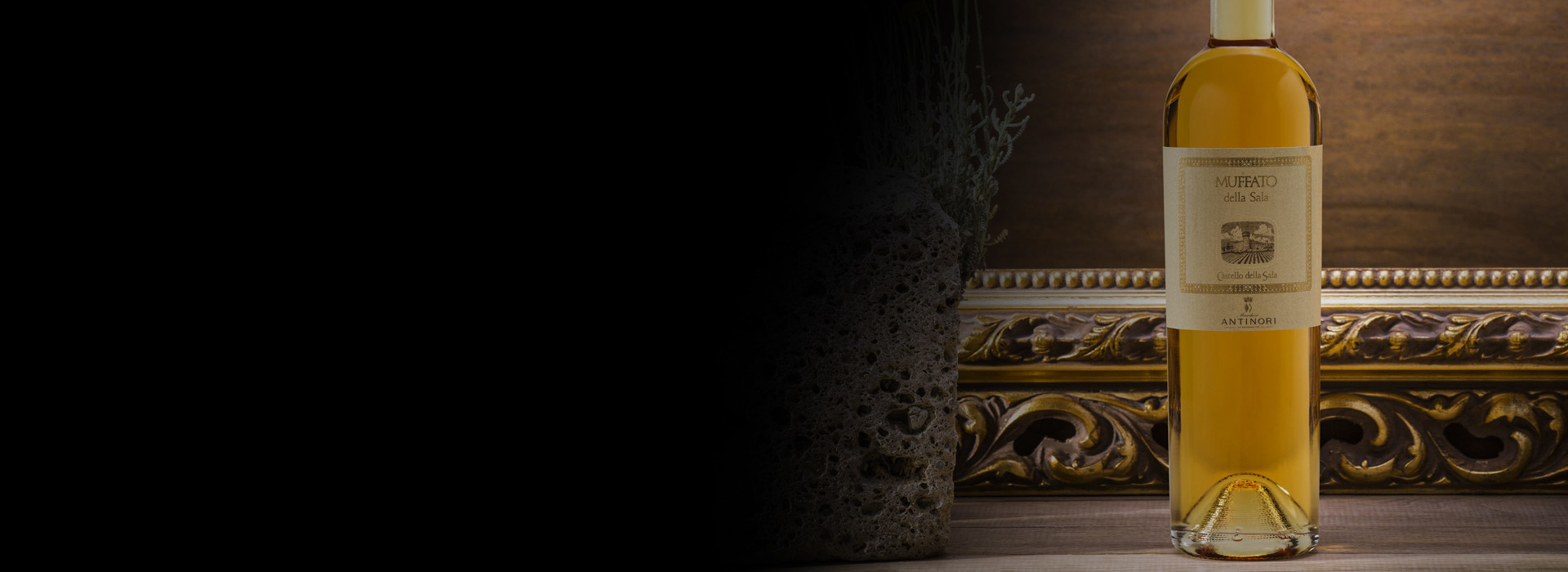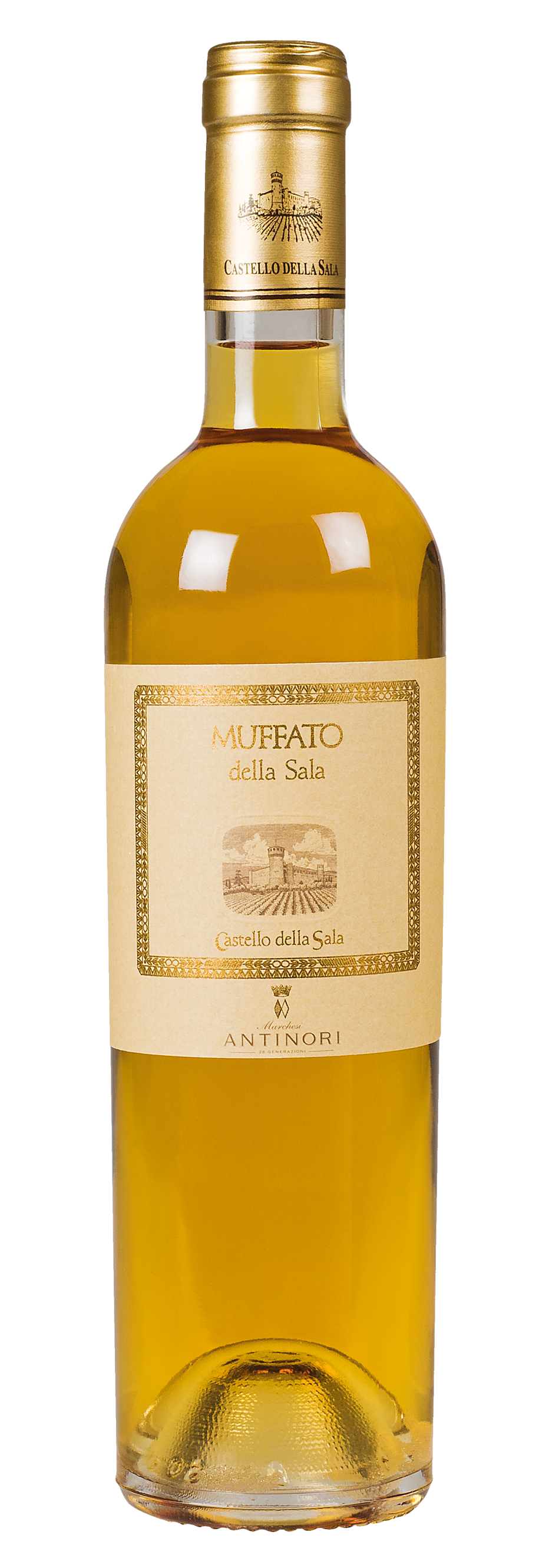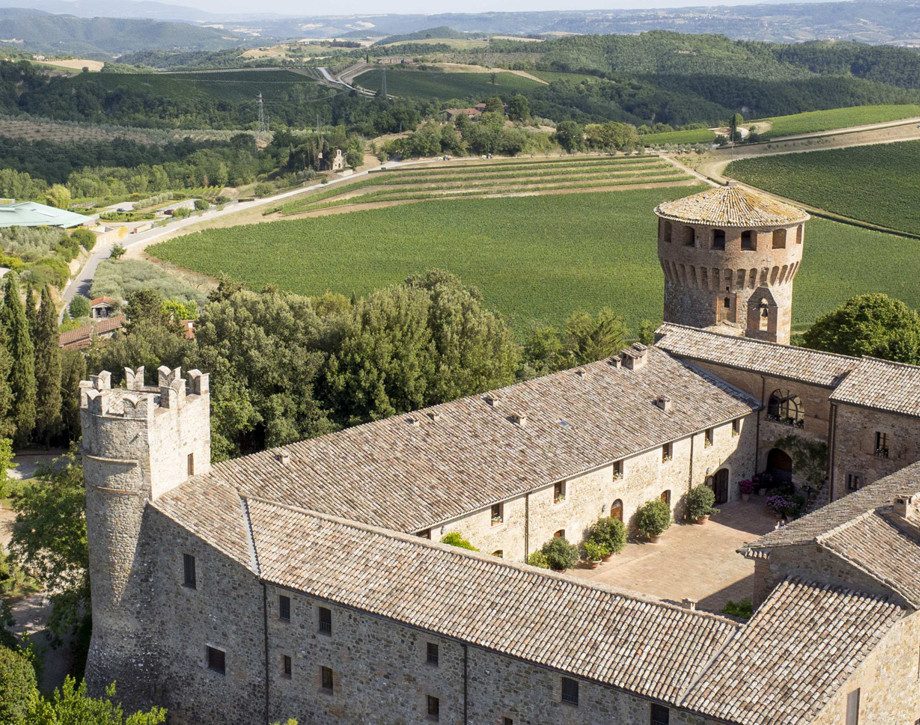Muffato della Sala

Climate
Spring-like temperatures and excellent supplies of ground water favored a positive bud-burst of all of the different grape varieties, slightly earlier than usual as well, and both flowering and bud-set proceeded equally smoothly. The rainfall of early summer assisted the vines in maintaining a good vegetative balance between the grapes and leaves even during the hot month of August, guaranteeing a complete color change in the grapes. “Noble rot” gradually covered the crop towards early autumn, without risks for the health of the grapes, concentrating their sugars and adding to their aromatic complexity. The harvest began towards the end of October with the Gewürztraminer and continued with the Riesling, the Sauvignon, and the Sémillon, concluding with the Grechetto in late November.
Vinification
The grapes are all sourced from the Castello della Sala vineyards, located between 825 and 1150 feet (250-350 meters) above sea level on clayey soils rich in marine fossils. The grapes were picked by hand in a series of passages through the vineyard, returning various times on the basis of the presence of Botrytis Cinerea - noble rot - on the grapes. Once in the cellars, the crop was given a further selection on a conveyor belt, and the grapes gently pressed without destemming. The must, after pressing, fermented for 18 days at temperatures around 62° Fahrenheit (17° centigrade). The wine, still sweet, then went into Allier and Tronçais oak barrels where it aged for approximately six months before being blended and bottled.
Historical Data
Muffato della Sala is produced with grapes with “noble rot”, harvested in late October and early November to allow the morning mists to develop of Botrytis Cinerea, or noble rot on the grape berries. This type of mould concentrates the water of the crop, its sugars, and its aromas, endowing the Muffato della Sala with a harmonious and unmistakable fragrance. The first year to be produced was the 1987 and consisted of the blend of varieties such as Sauvignon Blanc (50%); Grechetto (30%) and Drupeggio (20%). The composition of the blend has varied over the years and now has attained its definitive results. Muffato della Sala is a fascinating wine, an expression, in small quantities, of the nature of a unique terroir.
Tasting Notes
A brilliant golden yellow in color, the wine shows aromas of dried and candied fruit, nuts, and yellow flowers. Sweet on the palate, the wine is balanced by a highly pleasurable and invigorating freshness. The long aromatic persistence indicates an excellent potential for aging.
Awards
Wine Advocate 96/100 USA Falstaff 93/100 Austria

The Wine
This fascinating wine is a blend of Sauvignon Blanc, Grechetto, Traminer, Sémillon and Riesling affected by Botrytis Cinerea (noble rot). The morning mists and local microclimate favour the development of this rot which reduces the water content of the grapes. The resulting concentration of sugars and aromas give the Muffato its special and unmistakeable flavour.

Climate
Spring-like temperatures and excellent supplies of ground water favored a positive bud-burst of all of the different grape varieties, slightly earlier than usual as well, and both flowering and bud-set proceeded equally smoothly. The rainfall of early summer assisted the vines in maintaining a good vegetative balance between the grapes and leaves even during the hot month of August, guaranteeing a complete color change in the grapes. “Noble rot” gradually covered the crop towards early autumn, without risks for the health of the grapes, concentrating their sugars and adding to their aromatic complexity. The harvest began towards the end of October with the Gewürztraminer and continued with the Riesling, the Sauvignon, and the Sémillon, concluding with the Grechetto in late November.
Vinification
The grapes are all sourced from the Castello della Sala vineyards, located between 825 and 1150 feet (250-350 meters) above sea level on clayey soils rich in marine fossils. The grapes were picked by hand in a series of passages through the vineyard, returning various times on the basis of the presence of Botrytis Cinerea - noble rot - on the grapes. Once in the cellars, the crop was given a further selection on a conveyor belt, and the grapes gently pressed without destemming. The must, after pressing, fermented for 18 days at temperatures around 62° Fahrenheit (17° centigrade). The wine, still sweet, then went into Allier and Tronçais oak barrels where it aged for approximately six months before being blended and bottled.
Historical Data
Muffato della Sala is produced with grapes with “noble rot”, harvested in late October and early November to allow the morning mists to develop of Botrytis Cinerea, or noble rot on the grape berries. This type of mould concentrates the water of the crop, its sugars, and its aromas, endowing the Muffato della Sala with a harmonious and unmistakable fragrance. The first year to be produced was the 1987 and consisted of the blend of varieties such as Sauvignon Blanc (50%); Grechetto (30%) and Drupeggio (20%). The composition of the blend has varied over the years and now has attained its definitive results. Muffato della Sala is a fascinating wine, an expression, in small quantities, of the nature of a unique terroir.
Tasting Notes
A brilliant golden yellow in color, the wine shows aromas of dried and candied fruit, nuts, and yellow flowers. Sweet on the palate, the wine is balanced by a highly pleasurable and invigorating freshness. The long aromatic persistence indicates an excellent potential for aging.
Awards
Wine Advocate 96/100 USA Falstaff 93/100 Austria

Castello della Sala
Castello della Sala is located in the Umbria region, not far from the Tuscan border, about 18 kilometers from the historic city of Orvieto. The Medieval castle’s property extends over an area of 600 hectares (1482 acres), 229 hectares (495 acres) are planted with vineyards at an altitude that varies between 220 and 470 meters above sea level (722/1541 feet) on the gently rolling hillsides that characterize the beautiful countryside in this area. Castello della Sala is the perfect place for growing white varieties. The vines grow in clay and calcareous based soils, rich in fossil shells, and they are well exposed to the rising of the sun with an excellent difference of temperature between day and night. The one exception to the rule is Pinot Noir, the only red variety that has found in this area ideal growing conditions to best express its full potential.

Soil
Clay soils rich in deposits of marine fossils.


















